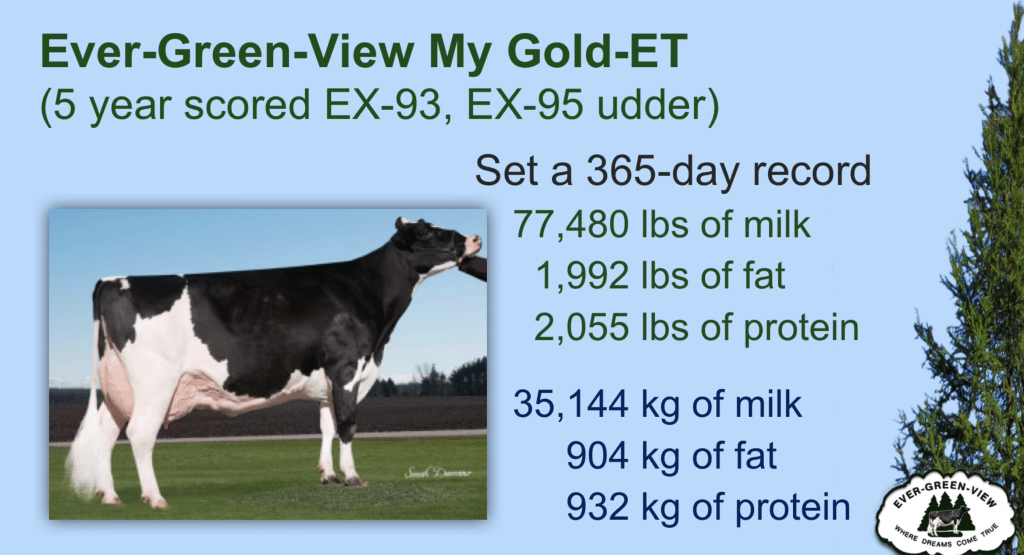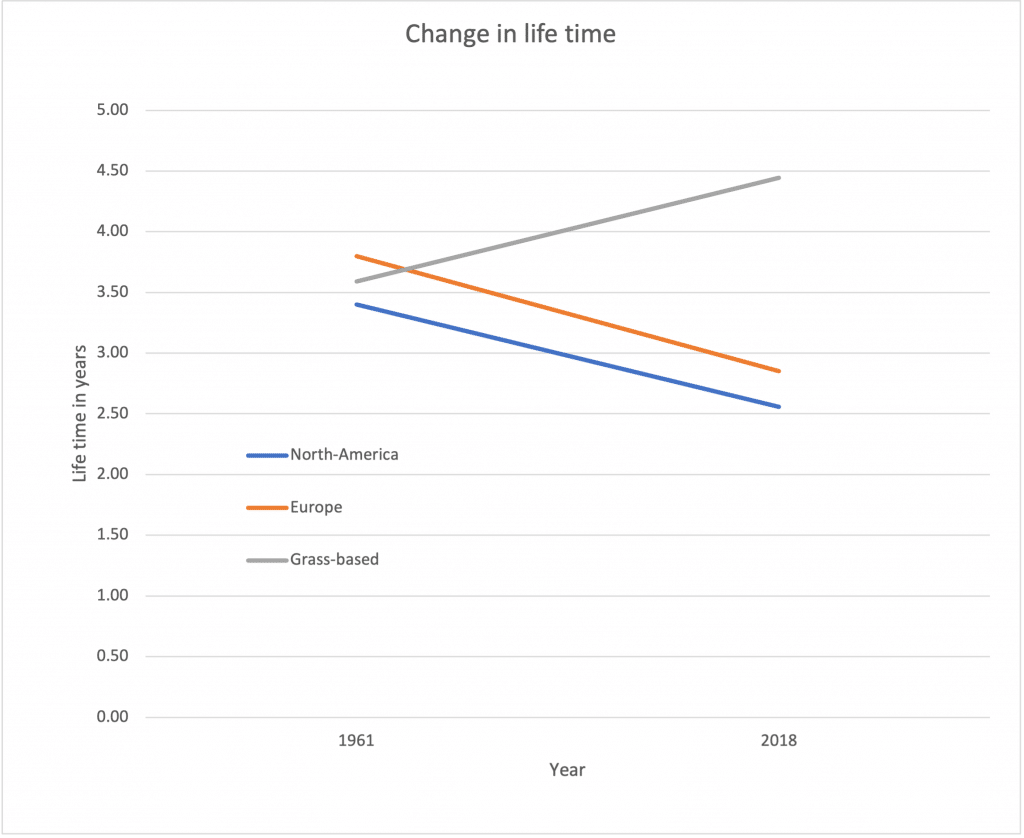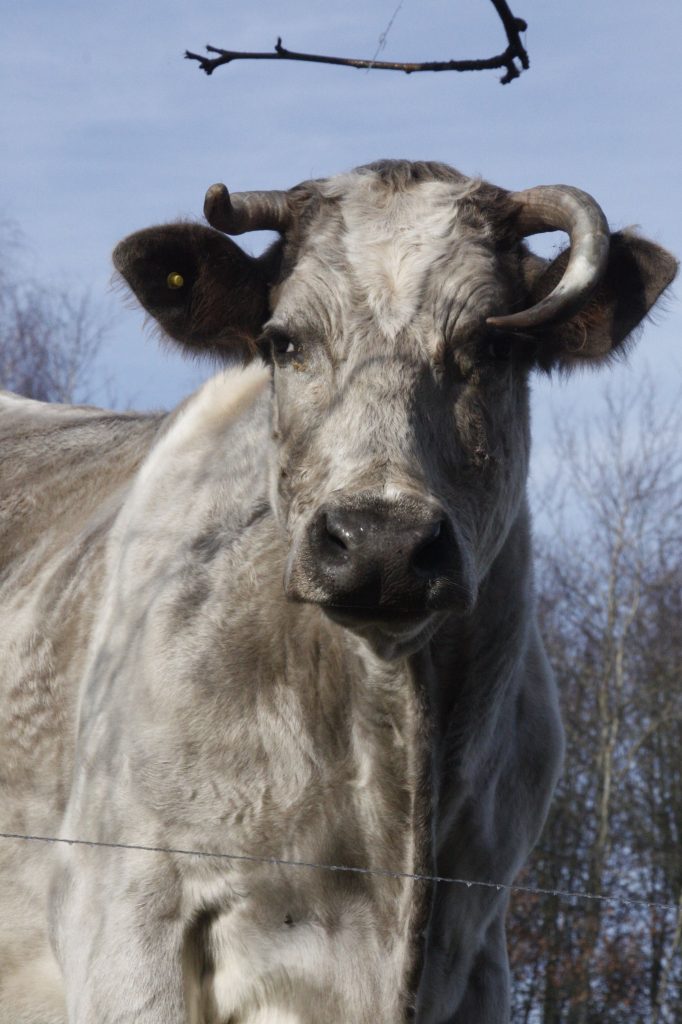Take home message
- Almost 60 years of changes in breeding and husbandry of dairy cows have resulted in the Holstein cow (big, tall, lean) achieving tremendous performance in terms of milk yield.
- This has come at the expense of the lifespan of today’s dairy cow. In countries with a lot of pasturing and a different type of cow (small, round, beefy), the milk yield per cow has also increased, however, also the lifespan of the cows.
From a cow on pasture to an indoor animal
What an animal will produce, depends on both nature and nurture, the interplay between genetics and environment. Cows have looked very different over the course of domestication. Roman excavations in the Netherlands at the beginning of the era brought up skeletons of cows in coastal areas, no larger than 100-110cm withers. After WW-II, the Netherlands was in focus due to the export of its Dutch-Frisian bulls. The cows in those days were round, conformed and 130-140cm withers. However, they were glibly overtaken by the American Holstein cows, where ‘big’ and ‘many’ started earlier. These Holstein cows were easily 150cm withers and lean. They increasingly set the tone in the world, as big cows simply produced the most milk. The world gradually turned from a cow that was regionally adapted to the local environment to a unitary farm, where the cow’s genetics determined what the environment (feed, barn, care) should meet.
A lot has changed in the last 60 years
Cows had limited feed intake due to their body size and the size of the rumen, one of the forestomachs. Breeding ‘big’ and ‘tall’ allowed a cow to digest more feed. By breeding ‘lean’, the cow put all its energy from feed into milk. Tall cows went hand in hand with the change in livestock nutrition: concentrates from grains, and soya which had a higher energy density than grass and hay. By making the forage component as small as possible, a cow could absorb a lot of energy per kg of dry matter intake. Plant and crop breeding evolved as well, and cows were increasingly offered feed stuffs with low crude fiber content, and therefore easily digestible feed. In fact, cows were fed more and more like pigs. In the US, they did not hesitate to improve the persistence of the milk yield through injection with growth hormone (Monsanto’s rBST) during lactation. The lactation curve flattened and cows maintained a higher milk yield for longer. It also helped when milking 3x daily instead of twice daily with the milking robot or by the Mexican staff. Preventing measures were taken to early mastitis or infertility. Numerous adaptations were made here: the barn became more spacious, sand beds, compost beds, water beds, but also antibiotic aids (drying off), vaccinations (against E.coli) and feed supplements (vitamins and minerals) were used to further increase productions. And of course, giving birth to a calf every year; each calf in turn gives rise to a lot of milk.
It was no longer possible to let the cow graze and produce milk from grass. Grass contains too little energy, is variable in quality and therefore unsuitable for such high-producing cows. They had to remain indoors, or stay in feedlots in hotter climates, where they received the same ration daily, weekly, monthly, no feed transitions and no stress. A new stress, however, did arise, namely heat stress. Producing milk goes hand in hand with the production of large amount of body heat. Cows and their barns had to be cooled, either with water evaporators or by air conditioning to the whole barn. Artificial insemination (AI) replaced family breeding with live bulls. Male influence became more important than female influence. A cow produced only a few calves; the bull selected for AI received thousands of offspring. Inseminators drove around at start with fresh semen, in the 1960s, then semen from bulls was frozen and stored. This meant, that a lot of bulls were still used at local AI stations, as it had to be as fresh as possible. With freezing technology, regional deployment disappeared. Frozen semen led to a huge spread of only a few top bulls around the world. It became increasingly lonely at the top. The result was a global deployment of few males, their sons and their grandsons. The biggest mistake still being made today is to use far too few males, which increased inbreeding on a global scale. The Dutch were proud again in the 1990s, when a Dutch AI bull broke through internationally. Sunny Boy got more than 1 million inseminations to his name. For some sire lines from the US, this is even crazier. Pawnee Farm Arlinda Chief and Round Oak Rag Apple Elevation are bull names from the last century that appear in almost all descendants of HF cows. Not once, but through their sons and (great) grandsons very frequently.
Melkproduction
Canadian researchers (Dallago et al., 2021) wrote a review on the current dairy farming practices. It is titled “Being able to keep dairy cows longer: a critical review of dairy cow longevity in high-yielding dairy cattle countries”. They described two key parameters that changed roughly between 1960 and 2020, namely milk production per cow and dairy cow longevity in different countries.
To keep things clear, we have simplified graphs based on their data. Cows have been divided into three groups: from North America (US and Canada), from Europe (France, Germany and Italy), and from countries where the cows graze (Ireland and New Zealand). The motivation to build these groups is, that the US has been especially leading in breeding (“leading”), as most Holstein cows worldwide can be traced back to a handful of breeding bulls from the US. Canada and the US have had a strong exchange in terms of genetics. Europe is next, following the US, when breeding shifted from Dutch Frisian to Holstein (“next”) in the 1970s. The other two countries have bred a totally different type of cow, adapted to pasturing (“grazing”). Based on the summarised data for each country over 30 to 40 years, the researchers calculated regression lines for milk production and for longevity over the period 1960-2020. Figure 1 shows the development of milk production per cow in the three groups of countries.

(derived from data of Dallago et al., 2021)
Remarkably, at the start (around 1960), differences between countries are small. The lines diverge widely after almost 60 years, and recently (2018), there are differences of roughly 9,500, 7,000 and 5,000 kg per cow per lactation. In each group there are obviously still differences present, but these data indicate a trend, which is related to their genetic position.
Wereldrecord-holder for milk
If you really look for the extremes in the US, you will find cows that produce about 35 tonnes of FPCM (fat- and protein-corrected amount of milk) in a single lactation, 35,000 kg of milk in 365 days, almost 100 kg a day. The cow Ever-Green-View My-Gold-ET was a very high-yielding cow, and her embryos and sons are flying around the world. These offspring will be known in the next 10 years with Chinese names or Arabian names from the Emirates. While American farmers bought the biggest cows from the Dutch provinces North Holland and Friesland at the end of the 19th century, now companies in China and the Middle East are buying up the top genetics. In 1880, cows and bulls were still shipped alive, anno 2020 we are flying semen and embryos around in liquid nitrogen.

Despite the low milk solids of My-Gold (fat 2.57%, protein 2.65%), the milk yield is obviously an enourmous achievement. If we assume, that such a Holstein cow weighs 900 kg, she produces about 3,000 kg of FPCM per 100 kg of body weight. This is huge compared to other cows and tells us where the potential milk yield of a dairy cow lies. The new challenge for the livestock industry is formulated now, to start keeping cows with 20,000 kg of milk per lactation (Pulina et al., 2020).
The cow’s life span
What age can a (dairy) cow reach? Besides the milk production per cow, countries often proudly showed another figure, namely the milk production in a cow’s lifetime. Cows that produced more than 100,000 kg of milk in their lifetime were honoured; in the Netherlands, the mayor sometimes used to come by to do this. However, the average productive life span of all dairy cows is poor. It takes about 24-27 months (over 2 years) for the cow to become a mother herself. This is called the rearing period from calf to pregnant heifer. After the 1st calving, animals must prove themselves in terms of production. Too low production means forced disposal. In addition, all sorts of things happen that prevent a cow from aging: for decades udder infection or too high somatic cell counts, infertility and claw problems have been listed as the main reason for disposal. Every year, about 30% of cows in the herd are replaced, and in roughly 3 years, all cows are replaced.
In their paper, the researchers (Dallago et al., 2020) also address changes in longevity of dairy cows. This outcome looks slightly different than the milk production figures. The same calculation was made as above in terms of milk production. We comined countries and converted on the period 1961-2018 for the three areas: ‘leading’ = North America, ‘following’ = Europe and ‘grazing’.

Regression lines for three different areas (derived from data of Dallago et al., 2021)
Around 1960, even longevity was not so different between countries. Roughly speaking, dairy cows lasted 3.5 lactations. The changes in America and Europe are similar: in 40 years, cows lost one productive year of life, more so in Canada than in the US itself. The two “grazing” countries showed an increase in longevity, one productive year added. To be fair, this is particularly the case in New Zealand, lifespan also declined in Ireland. However, in 2018, Ireland is at the level (about 3.5 years) where America and Europe started in 1961. This tall American Holstein type of cow is best held inside or in feed lots. Outside in the pasture she would starve, give herself away and emaciate because of her high milk yield. A totally different type of cow is needed, adapted for pasturing. These are worlds of difference, which can no longer fit together.

Literature
- Dallago, G. M., Wade, K. M., Cue, R. I., McClure, J. T., Lacroix, R., Pellerin, D., & Vasseur, E. (2021). Keeping Dairy Cows for Longer: A Critical Literature Review on Dairy Cow Longevity in High Milk-Producing Countries. Animals, 11(3), 808.
- Pulina, G., Tondo, A., Danieli, P. P., Primi, R., Matteo Crovetto, G., Fantini, A., … & Atzori, A. S. (2020). How to manage cows yielding 20,000 kg of milk: Technical challenges and environmental implications. Italian Journal of Animal Science, 19(1), 865-879.
Foto: mother and aunt lick and clean the newborn calf in a paddock in New Zealand




